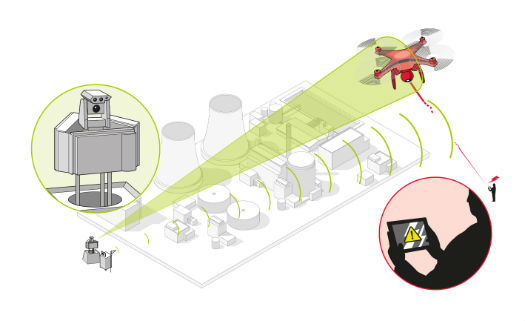Long distance drones jammer-Take down drones !!!Kkkkk
The battle for control of the skies continues. As the amount of unmanned aerial vehicles (UAVs) increases each year, contracting parties are stepping up their efforts to keep the devices out of the air. Battelle, a large nonprofit research and development organization headquartered in Ohio, has now developed a portable, shoulder-mounted rifle, dubbed the DroneDefender, that attacks UAVs with radio waves.
In a press release from Battelle, the gun is stated to use “radio control frequency disruption technologies to safely stop drones in the air, before they can pose a threat to military or civilian safety.” A video accompanying the post describes that it operates on standard GPS and ISM radio bands, allowing for it to interference with commercial UAV signals.
Reportedly, the DroneDefender can hit objects up to 400 meters with an effective cone diameter of 30°. This is about as far as Battelle goes with the technical details, so the actual frequency ranges of the rifle still remain unknown. However, it is easy to determine which ISM radio bands they most likely run on by looking at the consumer UAV market.
The DJI Phantom series, for example, as seen in video above, shows that the DroneDefender is likely targeting the 2.4 GHz range (if it is attacking the Phantom 1 or Phantom 2). This puts them on the same range as standard Wi-Fi networks, Bluetooth connections, microwave ovens, car alarms, baby monitors, and ZigBee devices. To disrupt the GPS signal, the rifle needs to broadcast at 1575.42 MHz or 1227.60 MHz, depending on the UAV.
When a remote control signal is interfered with, drones will often enter into their safety protocols, which usually includes one of three options. It will either hover in place until the pilot can regain a control link, attempt to land so the pilot can recover it physically, or try to return to its point of origin. Since the DroneDefender is mentioned to be attacking the GPS signal as well, the likely scenario is that the device will hover for a while or try to land.
On a legal standpoint, the DroneDefender seems to be in a grey area. According to FCC regulations, federal law prohibits the operation, marketing, or sale of any type of jamming equipment, including devices that interfere with cellular and Personal Communication Services (PCS), police radar, Global Positioning Systems (GPS), and wireless networking services (Wi-Fi). Operation of a jammer in the United States may result in substantial monetary penalties, seizure of the unlawful equipment, and criminal sanctions including imprisonment.
The main reason for outlawing radio jamming equipment has to do with ensuring that emergency signals are not interfered with. If an accident occurs and a signal gets disrupted, lives could be at risk.
However, some states are proposing legislation, like in California, that would allow firefighters and authorities to take down drones if they are interfering with an emergency situation like a wildfire. Blocking approach paths to airports, hovering over fires, and flying over freeways could be considered instances where those drones can be shot down. However, whether or not officials would legally be allowed to use a radio jammer like the DroneDefender remains unclear.
For now, the video stands as a testament to the increasing influence that UAVs are having on society. People on both sides of the issue are arguing about whether drones should be allowed to fly in various areas and whether or not people are legally authorized to take them down. Surely, additional videos like this will surface over time, sparking further discussions along the way.
Long distance drones jammer-Take down drones!!!
C.T.S TECHNOLOGY CO., LIMITED

Replies